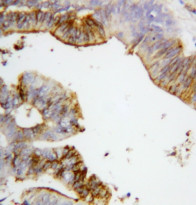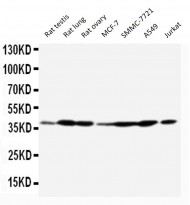ARG59026
anti-Annexin A2 antibody
anti-Annexin A2 antibody for IHC-Formalin-fixed paraffin-embedded sections,Western blot and Human,Mouse,Rat
Overview
| Product Description | Rabbit Polyclonal antibody recognizes Annexin A2 |
|---|---|
| Tested Reactivity | Hu, Ms, Rat |
| Predict Reactivity | Hm |
| Tested Application | IHC-P, WB |
| Host | Rabbit |
| Clonality | Polyclonal |
| Isotype | IgG |
| Target Name | Annexin A2 |
| Antigen Species | Human |
| Immunogen | Synthetic peptide corresponding to aa. 121-141 of Human Annexin A2 (RAEDGSVIDYELIDQDARDLY). |
| Conjugation | Un-conjugated |
| Alternate Names | Placental anticoagulant protein IV; LPC2; Protein I; Calpactin-1 heavy chain; Calpactin I heavy chain; p36; CAL1H; ANX2; LPC2D; Lipocortin II; ANX2L4; HEL-S-270; LIP2; Annexin II; Annexin A2; Annexin-2; P36; Chromobindin-8; PAP-IV |
Application Instructions
| Application Suggestion |
|
||||||
|---|---|---|---|---|---|---|---|
| Application Note | IHC-P: Antigen Retrieval: By heat mediation. * The dilutions indicate recommended starting dilutions and the optimal dilutions or concentrations should be determined by the scientist. |
Properties
| Form | Liquid |
|---|---|
| Purification | Affinity purification with immunogen. |
| Buffer | 0.2% Na2HPO4, 0.9% NaCl, 0.05% Thimerosal, 0.05% Sodium azide and 5% BSA. |
| Preservative | 0.05% Thimerosal and 0.05% Sodium azide |
| Stabilizer | 5% BSA |
| Concentration | 0.5 mg/ml |
| Storage Instruction | For continuous use, store undiluted antibody at 2-8°C for up to a week. For long-term storage, aliquot and store at -20°C or below. Storage in frost free freezers is not recommended. Avoid repeated freeze/thaw cycles. Suggest spin the vial prior to opening. The antibody solution should be gently mixed before use. |
| Note | For laboratory research only, not for drug, diagnostic or other use. |
Bioinformation
| Database Links | |
|---|---|
| Gene Symbol | ANXA2 |
| Gene Full Name | annexin A2 |
| Background | This gene encodes a member of the annexin family. Members of this calcium-dependent phospholipid-binding protein family play a role in the regulation of cellular growth and in signal transduction pathways. This protein functions as an autocrine factor which heightens osteoclast formation and bone resorption. This gene has three pseudogenes located on chromosomes 4, 9 and 10, respectively. Multiple alternatively spliced transcript variants encoding different isoforms have been found for this gene. [provided by RefSeq, Jul 2008] |
| Function | Calcium-regulated membrane-binding protein whose affinity for calcium is greatly enhanced by anionic phospholipids. It binds two calcium ions with high affinity. May be involved in heat-stress response. Inhibits PCSK9-enhanced LDLR degradation, probably reduces PCSK9 protein levels via a translational mechanism but also competes with LDLR for binding with PCSK9. [UniProt] |
| Cellular Localization | Secreted, extracellular space, extracellular matrix, basement membrane. Melanosome. In the lamina beneath the plasma membrane. Identified by mass spectrometry in melanosome fractions from stage I to stage IV. Translocated from the cytoplasm to the cell surface through a Golgi-independent mechanism. [UniProt] |
| Calculated MW | 39 kDa |
| PTM | Phosphorylation of Tyr-24 enhances heat stress-induced translocation to the cell surface. ISGylated. [UniProt] |
Images (3) Click the Picture to Zoom In
-
ARG59026 anti-Annexin A2 antibody IHC-P image
Immunohistochemistry: Paraffin-embedded Human intestinal cancer tissue stained with ARG59026 anti-Annexin A2 antibody.
-
ARG59026 anti-Annexin A2 antibody WB image
Western blot: Rat testis, Rat lung, Rat ovary, MCF-7, SMMC-7721, A549 and Jurkat lysates stained with ARG59026 anti-Annexin A2 antibody.
-
ARG59026 anti-Annexin A2 antibody WB image
Western blot: 50 µg of sample under reducing conditions. Mouse spleen and NIH/3T3 whole cell lysates stained with ARG59026 anti-Annexin A2 antibody at 0.5 µg/ml dilution, overnight at 4°C.








